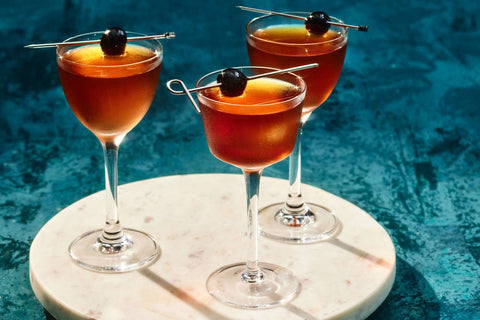McLaren Vale, renowned for its premium wines, is also witnessing a surge in artisanal spirit production. Among the innovative creations emerging from this South Australian region is blue gin, a captivating spirit that owes its distinctive hue to a fascinating botanical: the butterfly pea flower.
This article delves into the production of blue gin in McLaren Vale, exploring the role of butterfly pea, the science behind its colour, the expected flavour profile, and the cocktails that showcase this visually stunning spirit.
The Enchanting Butterfly Pea: A Thai Botanical
The key ingredient that sets blue gin apart is the butterfly pea flower (Clitoria ternatea), a flowering legume native to Thailand and Southeast Asia.
-
Botanical Characteristics: The butterfly pea is known for its vibrant blue petals. These petals contain high concentrations of anthocyanins, a type of natural plant pigment responsible for blue, purple, and red colours in various fruits, vegetables, and flowers.
-
Traditional Uses: In traditional medicine, butterfly pea has been used for its purported health benefits. It's also used in Thai cuisine for colouring rice and desserts.
-
Gin Infusion: In gin production, the butterfly pea flower is typically added during the post-distillation infusion process. This means the base gin is distilled first, and then the butterfly pea petals are steeped in the spirit to extract their colour and subtle flavour.
The Science of Blue: Anthocyanin's Role
The remarkable colour-changing properties of butterfly pea are due to the sensitivity of anthocyanins to pH levels.
-
pH Sensitivity: In a neutral or alkaline solution, anthocyanins appear blue. When an acid is added, the colour shifts towards purple or pink.
-
Gin's Acidity: Gin has a slightly acidic pH. However, the botanical balance and the way the butterfly pea is infused influence the final hue.
-
Colour Transformation: The most dramatic demonstration of this pH sensitivity occurs when an acidic mixer, such as tonic water (which contains quinine, also slightly acidic), is added to blue gin. The gin will visibly change colour, often swirling through shades of purple and pink before settling into a more violet or mauve tone. This colour transformation is a key feature of blue gin cocktails.
Expected Taste Profile: Beyond the Colour
While the visual spectacle is a major draw, blue gin also offers a unique taste experience.
-
Subtle Floral Notes: Butterfly pea flowers contribute a subtle floral character to the gin, often described as delicate and slightly sweet.
-
Traditional Gin Botanicals: Blue gin is still fundamentally gin, so it retains the classic juniper backbone along with other traditional botanicals like coriander, angelica root, and citrus peel.
-
Balance and Complexity: The best blue gins strive for a balance between the subtle floral notes of the butterfly pea and the complex interplay of traditional gin botanicals.
-
McLaren Vale Influence: McLaren Vale's climate and terroir might subtly influence the base spirit and the overall flavour profile, contributing to the gin's character.
Cocktails that Showcase Blue Gin: A Visual and Gustatory Delight
Blue gin's vibrant colour and colour-changing properties make it a star in creative cocktails.
-
The Blue Gin & Tonic: This classic cocktail is elevated by the colour transformation. The addition of tonic water creates a visually stunning drink that's both refreshing and intriguing.
-
The Blue Aviation: A variation on the classic Aviation cocktail, using blue gin instead of crème de violette. This results in a beautiful, layered drink.
-
The Colour-Changing Martini: A sophisticated and visually captivating martini where the addition of a dash of citrus juice causes a subtle colour shift.
-
The Butterfly Pea Sour: A twist on the traditional gin sour, featuring the floral notes of blue gin.
-
Layered Cocktails: Blue gin's density and colour make it ideal for creating visually striking layered cocktails.
Cost Considerations: Crafting a Unique Spirit
The cost of producing blue gin in McLaren Vale can vary.
-
Botanical Sourcing: The sourcing and quality of the butterfly pea flowers influence the cost.
-
Distillation Process: The skill and equipment used in the distillation process contribute to the gin's quality and price.
-
Batch Size: Small-batch, handcrafted gins tend to be more expensive.
-
Packaging and Marketing: Unique packaging and marketing efforts can also affect the final price.
Key Features:
-
Distinctive blue colour derived from butterfly pea flowers.
-
Colour-changing properties due to anthocyanin's pH sensitivity.
-
Subtle floral notes complementing traditional gin botanicals.
-
Visually stunning cocktails showcasing the colour transformation.
-
Crafted in McLaren Vale, a region known for its premium wines.
-
A unique and innovative approach to gin production.
FAQ's:
Q: What gives blue gin its colour?
A: The vibrant blue colour comes from anthocyanin pigments in butterfly pea flowers.
Q: Does blue gin taste significantly different from regular gin?
A: Blue gin retains the classic gin flavour profile but has added subtle floral notes from the butterfly pea.
Q: Will blue gin always change colour when mixed?
A: Yes, it will change colour when mixed with acidic ingredients like tonic water or citrus juice.
Q: Where is blue gin made in Australia?
A: Blue gin is produced by several distilleries, like the McLaren Vale Cellars in South Australia.
Q: Is butterfly pea safe to consume?
A: Yes, butterfly pea flowers are safe for consumption and have been used in food and drinks for centuries.



Comments (0)
There are no comments for this article. Be the first one to leave a message!